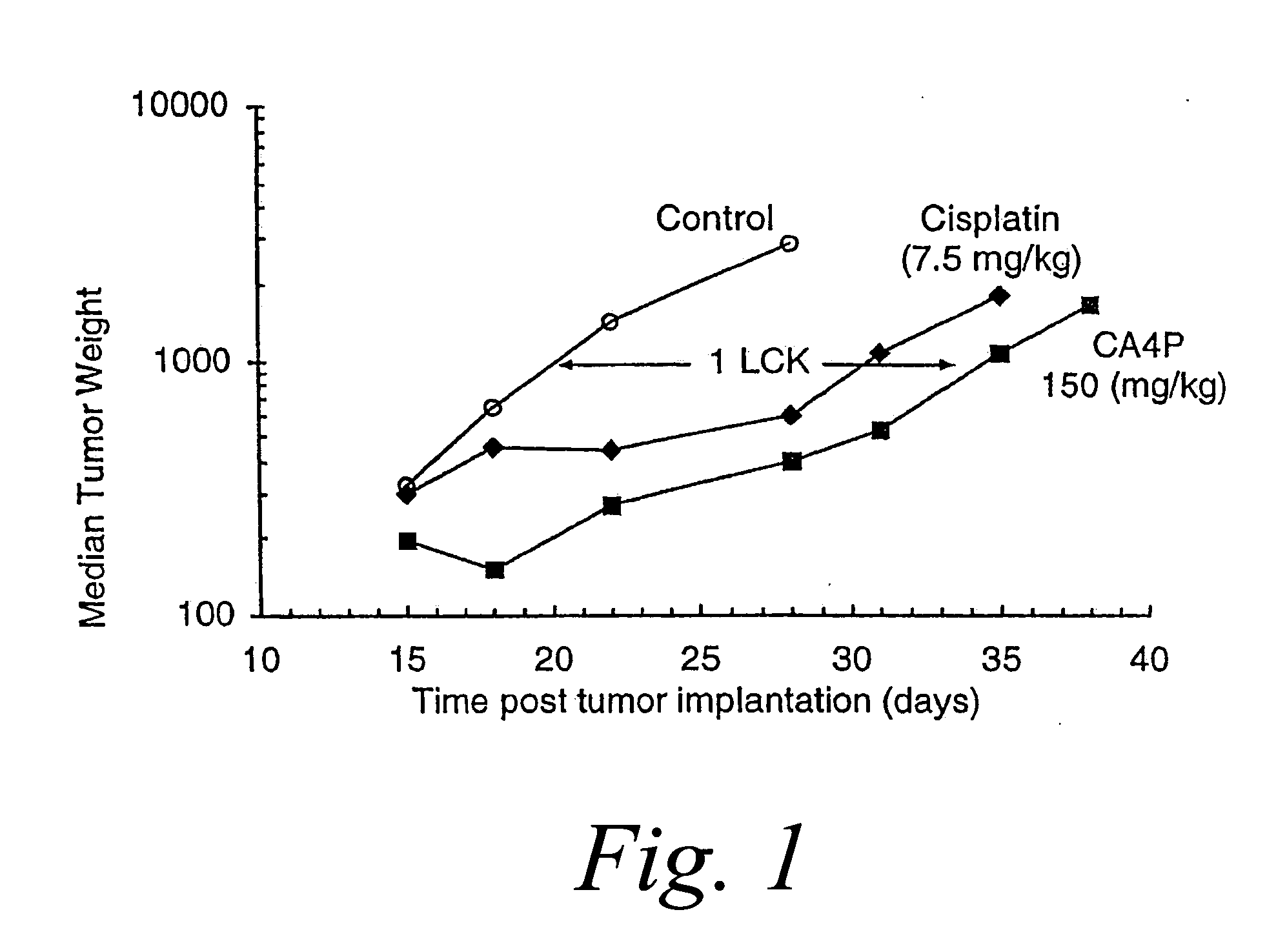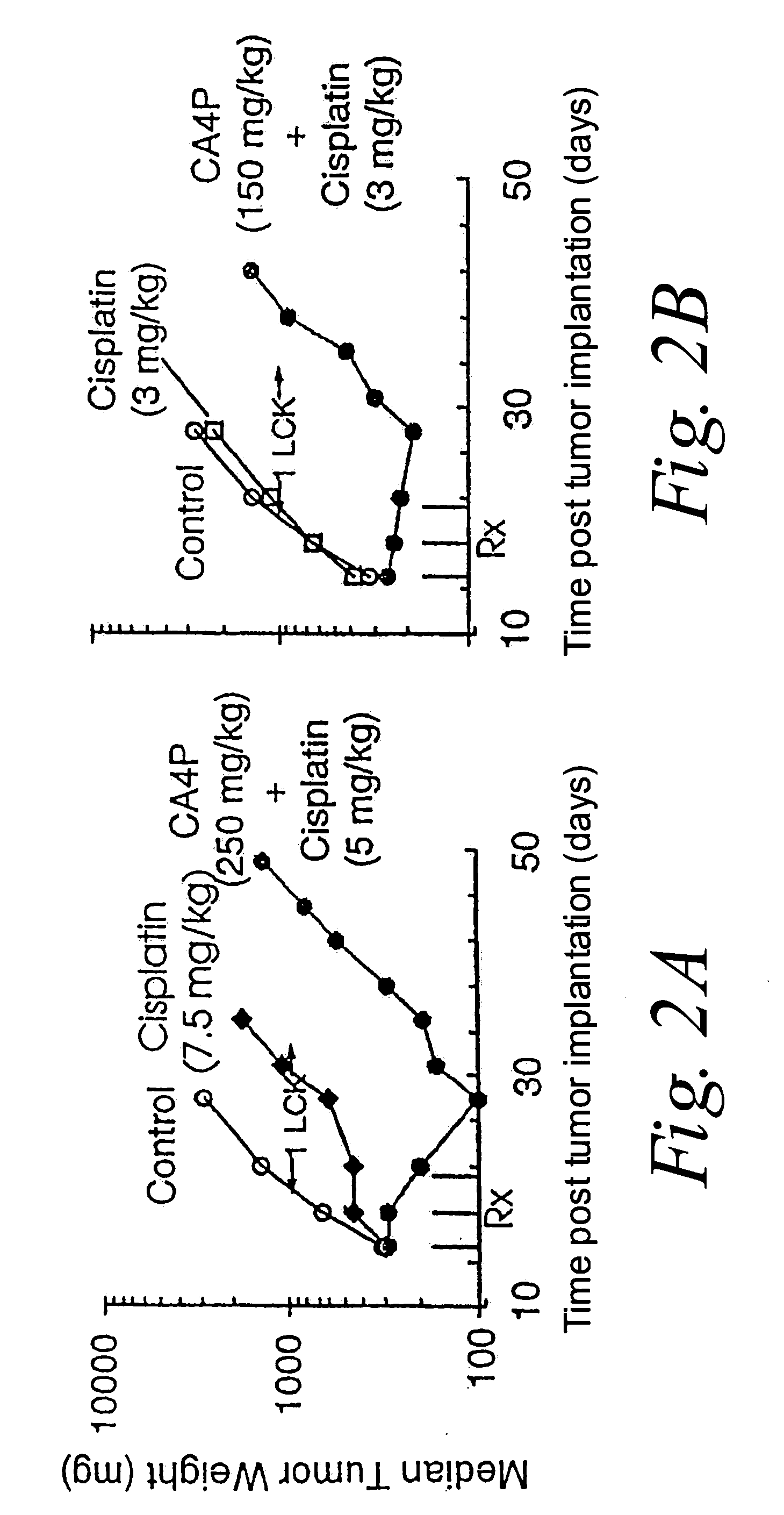Methods for modulating tumor growth and metastasis
- Summary
- Abstract
- Description
- Claims
- Application Information
AI Technical Summary
Benefits of technology
Problems solved by technology
Method used
Image
Examples
example 1
Two-Component Combination Chemotherapy
[0131] M507 6DDP is a murine fibrosarcoma that has developed resistance to cisplatin and cross-resistance to carboplatin. The in vivo antitumor activity of CA4P or CA1P in combination with each of these platinum coordination compounds and CPT-11 were evaluated in M5076DDP tumor bearing mice.
i) CA4P+Cisplatin
[0132] CA4P treatment of mice bearing advanced (300 mg) M507 6DDP tumors using an everyday×10 (Monday thru Friday) schedule produced moderate but significant antitumor effects. At its optimal dose (150 mg / kg / inj), combretastatin A-4 phosphate disodium salt yielded 1.1 log cell kill (LCK). In comparison, single agent cisplatin produced 0.8 log cell kill (LCK) at its maximum tolerated dose (MTD) of 7.5 mg / kg when injected every 4 days for 3 doses (Q4D×3). In comparison, the combination of CA4P (250 mg / kg / inj)+Cisplatin (5 mg / kg / inj), administered simultaneously, achieved a 2.0 LCK, which is consistent with a synergistic effect between CA4P ...
example 2
Three-Component Combination Chemotherapy
[0147] A study was conducted to assess the effects of administering a combretastatin in combination with both a taxane and a platinum coordination compound. The triple drug cocktail of CA4P in combination with the standard chemotherapeutic regimen of carboplatin and paclitaxel was chosen for investigation. In addition, a number of sequences of administration were studied.
[0148] A human breast adenocarcinoma model was established by subcutaneous injection of cultured MDA-MB-231 cells in Fox Chase CB-17 SCID mice. When the average tumor size reached 50-100 mm3, mice were randomly divided into several groups (I-VII) with no significant difference in body weight and tumor size. On Day 0, each group was administered anti-cancer agents. Group I mice were administered saline carrier only as a control treatment. Group II mice received an intraperitoneal (i.p.) injection of paclitaxel at a dose of 9 mg / kg, followed 30 minutes later by an infusion of ...
example 3
Treatment of Drug-Resistant Tumors
[0149] A study was conducted to assess the effects of administering a combretastatin in combination with both a taxane and a platinum coordination compound for treatment of drug resistant tumors. The effectiveness of a triple drug cocktail (a combretastatin+paclitaxel+carboplatin) was investigated in tumors that are resistant to a standard-line combination chemotherapy of carboplatin and paclitaxel.
[0150] The multi-drug resistant ES2 human clear cell ovarian carcinoma was established by subcutaneous injection of cultured ES2 cells in Fox Chase CB-17 SCID mice. In one experiment, tumor-bearing mice were administered CA4P at a dose of 100 mg / kg (Group II), saline carrier only (Group I), an intraperitoneal (i.p.) injection of paclitaxel at a dose of 9 mg / kg, followed 30 minutes later by an infusion of carboplatin at a dose of 30 mg / kg (Group II), or CA4P (100 mg / kg) followed 24 hours later by paclitaxel and carboplatin as in Group II (Group IV). Trea...
PUM
| Property | Measurement | Unit |
|---|---|---|
| Time | aaaaa | aaaaa |
| Time | aaaaa | aaaaa |
| Dimensionless property | aaaaa | aaaaa |
Abstract
Description
Claims
Application Information
 Login to View More
Login to View More - R&D
- Intellectual Property
- Life Sciences
- Materials
- Tech Scout
- Unparalleled Data Quality
- Higher Quality Content
- 60% Fewer Hallucinations
Browse by: Latest US Patents, China's latest patents, Technical Efficacy Thesaurus, Application Domain, Technology Topic, Popular Technical Reports.
© 2025 PatSnap. All rights reserved.Legal|Privacy policy|Modern Slavery Act Transparency Statement|Sitemap|About US| Contact US: help@patsnap.com



